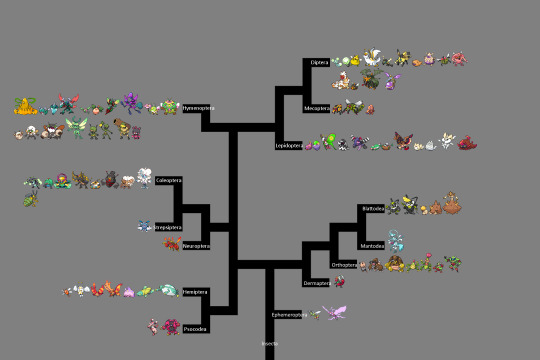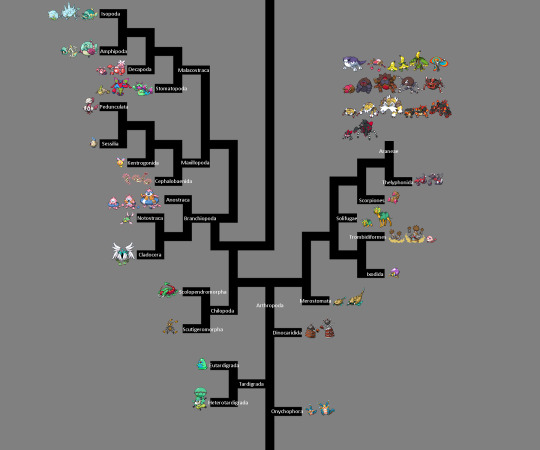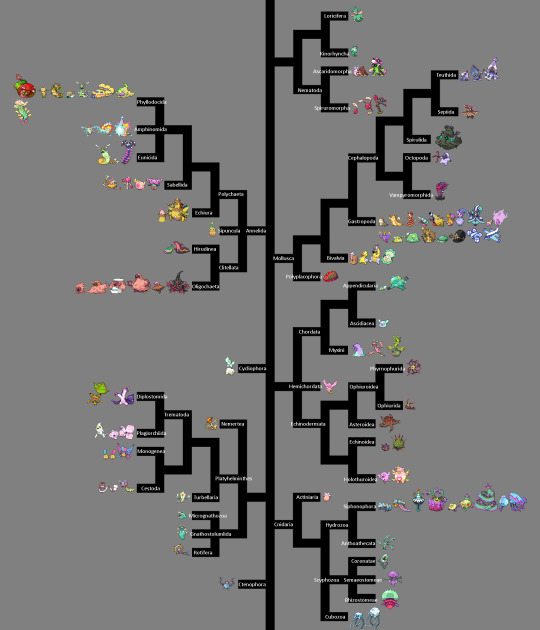#phylogenetic tree
Text

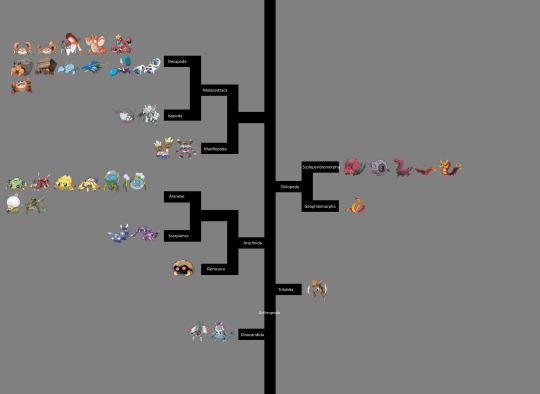

Phylogenetic Tree of Invertebrate Pokemon (Gen 9 Edition)
3K notes
·
View notes
Text
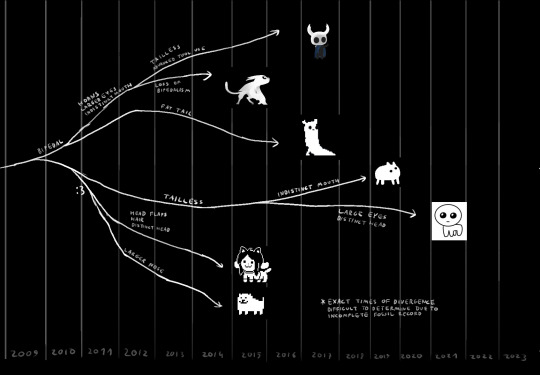
Tried to put together a decently parsimonious phylogeny
#evolution of these guys#tbh#autism creature#rainworld#rain world#hollow knight#undertale#deltarune#other stuff probably#cladistics#phylogeny#phylogenetic tree
1K notes
·
View notes
Text
Monsterverse Titan Phylogeny & Taxonomy

So, I was bored, and instead of studying for an upcoming test, I procrastinated and made a phylogenetic tree (a Tree of Life) and some proper scientific names for the Titans we have seen in the Monsterverse! The names in the official canon make no taxonomic sense. Titanus mosura and Titanus behemoth sound cool and all, but that implies that all the Titans are the same Genus, which.... no. Just, no.
I hope you guys enjoy it! I am always happy to answer any questions you have about it in the comments.
Scientific Names:
Shinomura - Parasitas collonium (parasitic colony)
Na Kika - Polypusoccult iridescentia (secret iridescent octopus)
Scylla - Lolligan testa (giant squid with legs)
Mothra - Vespulinea luxideu mosura (wasp light-god Mothra)
MUTO - Magnenator phagos (magnetic eater eater)
Amhuluk - Daemopampinus deceoculi (demon tendril with ten eyes)
Methuselah - Montivitae cornutum (living mountain with horns)
Skull Crawler - Reptant cranium (basic reptile skull)
Ion Dragon - Dracdum pisicut (fish-like ion dragon)
Tiamat - Serpensbellum tempestas (war serpent of storms)
Rodan - Pyranodon ventus (toothless winds of fire)
Doug - Deumigale optimum (best god gecko)
Shimo - Deureptilus glaciei (god reptile of the ice)
Godzilla - Deureptilia solis gojira (god reptile of the sun)
Behemoth - Dentesimia mehemot (tusked ape behemoth)
Frost Vark - Nasasidus fodiens (star nose digger)
Camazotz - Solhostis vespermortem (sun enemy death bat)
Skar King / Suko - Deupithepongo sapiens (wise god orangutan)
Kong - Deupithecus sapiens (wise god ape)
ALSO: Because Ghidorah is not of Earth, he wouldn't be ANYWHERE on a phylogenetic tree of Earth animals. Nowhere close at all. But his scientific name could be Interfectorum inanis (void killer).
#monsterverse#godzilla#legendary monsterverse#biology#taxonomy#Linnean classification#scientific names#science#proper science#phylogeny#phylogenetic tree#tree of life#doug#shimo#kong#skar king#discussion#science literacy#headcanons#rodan#mothra
29 notes
·
View notes
Text

It’s finally here! The new and improved 2023 version of my Piscine wyverns, most leviathans, and true elder dragons phylogenetic tree.
There is quite the substantial difference between this version and the older ones. Each species profile is also more in depth than my last tree, the flying wyvern tree, because there’s a lot more room for speculation in these monsters. A lot of this is also recontextualizing and reworking many outlandish traits some of these monsters have and basically giving a lot of canon/what some of the hunters guild tells us the middle finger. Some of the scientific names for the families were made by my fellow poopenshitter TheCuriousOne. They came up with the names for their own tree and allowed me to use some of these names too.
Because the written description is almost 100,000 characters long, I had to put it in a google doc that you can read here! I even added a chapter index so you can skip to the families you want to read.
This is probably the most in depth monster hunter cladogram on the internet
#monster hunter#monster hunter biology#monsterhunter#monhun#speculative evolution#speculative biology#speculative zoology#speculative anatomy#phylogeny#phylogenetics#phylogenetic tree#taxonomy#cladogram#cladograms#elder dragons#piscine wyverns#leviathans#monster hunter rise#monster hunter world
103 notes
·
View notes
Text

[Image ID: a speculative phylogenetic tree for all living things in Minecraft, including mobs and any "plant" or "fungus" lifeforms. The phylogenetic tree is illustrated using images from the game. The three highest domains are: Gramina, including grasses, vegetables, and most trees; Prismata, including creepers, slimes, and squids; and Velamina, including all fungi-like lifeforms, most animals, symbiotes (Wither and golems), and flowering plants. /.End ID]
Minecraft evolutionary tree of life, inspired by this one by NitroHydroRay. But in this one, life evolved very differently than it did on our world (it is UNHINGED). Click to zoom.
The clades are all invented, and I tried to name most clades (the ones lower than the three highest domains) according to the zoological guidelines: purple = superfamily, blue = family, green = subfamily, yellow = tribe, orange = subtribe.
#minecraft#speculative evolution#minecraft evolution#phylogeny#minecraft taxonomy#taxonomy#speculative taxonomy#medieval bestiary#phylogenetic tree#evolution#speculative biology
6 notes
·
View notes
Text

I think most people are aware of the fact that humans are related to other primates such as chimps, gorillas, mandrills and probably even Curious George. As a matter of fact, humans ARE primates, which means we share a common ancestor with all other primates. The order Primate includes many species other than just humans and animals that we usually call "monkeys", it also includes lemurs and some other minor families.
However, what I was curious to know was what animals are the most closely related to humans after the primates. To find out, we need to go up the ranks in our phylogenetic tree. As seen on the image on top, primates are part of the mirorder (like an order, but bigger) Primatomorpha, which includes the order Dermoptera (yes, Greek nerds, this means something along the lines of "wing skin"). The order Dermoptera consists entirely of colugos, which are also known as flying lemurs. Despite their name, they are not lemurs and despite their appearance, they are not flying squirrels. They just happen to also be equipped with a patagium (the skin membrane they use to glide) due to convergent evolution. While this is surely interesting, colugos are quite obscure animals and I was looking for a group of animals that would be more "commonly known", even if a bit less related to humans.
We can go even higher up in our phylogenetic tree and see that Primatomorpha are part of the grandorder (like a mirorder, but even bigger) Euarchonta and have a sister order, Scandentia. Animals in the order Scandentia are referred to as "tree shrews", but again, the name is misleading because while they are indeed arboreal, they are not shrews. The image above has one example of these creatures, a tupaia, and while they are cute and all, they are still not what I would call a "commonly known animal". Also, note that the position of the order Scandentia in the evolutionary tree is actually debatable as some researchers place them as a sister clade* to the Glires.
Going one more rank up in our phylogenetic tree, we see that Euarchonta are part of the superorder (like a grandorder, but bigger, you get the idea) Euarchontoglires, which includes the clade Glires. Within this clade are found the orders Lagomorpha and Rodentia, which are both comprised of very well known animals, such as rabbits and rats. I think it's pretty cool to think that those animals are quite closely related to primates, and therefore, to humans. Probably this is why they are (sadly) used for animal testing of medicine and cosmetics, although they are also probably used because of economical reasons.
* I will one day make a post about this word, it's actually pretty interesting.
#animals#primates#humans#colugo#order#clade#dermoptera#primatomorpha#scandentia#euarchonta#euarchontoglires#glires#phylogenetic tree#phylogeny
8 notes
·
View notes
Text
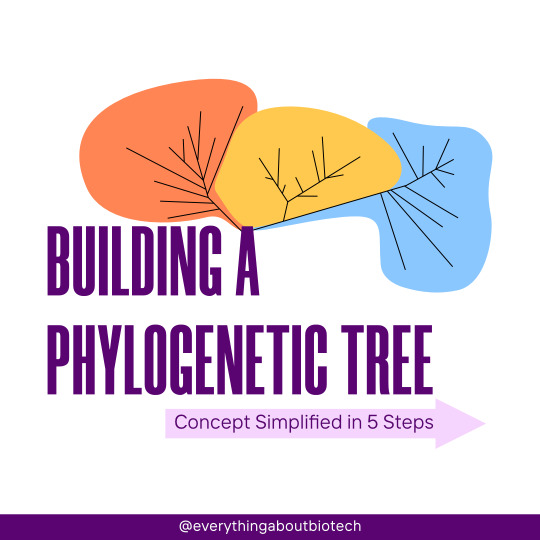
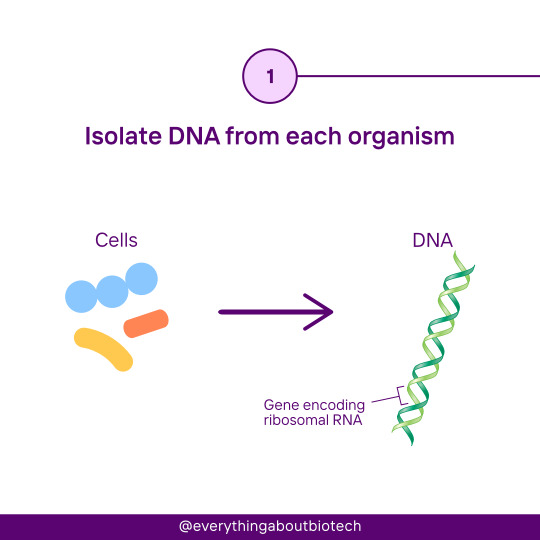


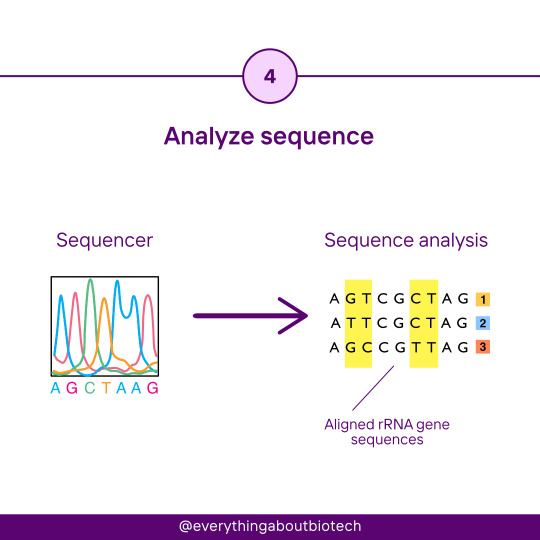
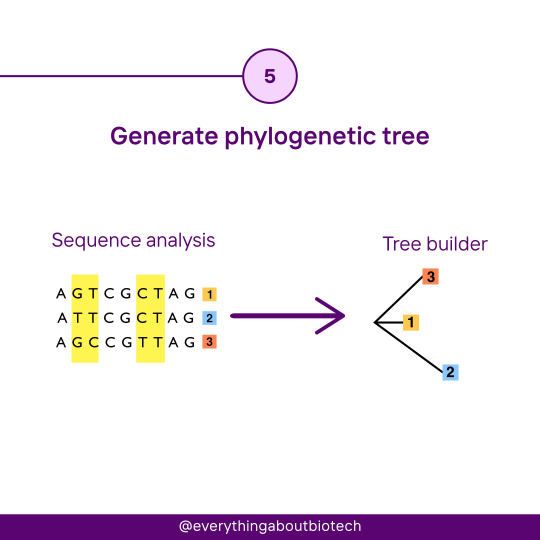

#phylogenetic#phylogenetic tree#phylogeny#tree of life#bioinfo#bioinformatics#biotechnology#biotech#science#biology#biochemistry#studyblr#molecularbiology#notes#class notes#students#science illustration#illustration#illustragram#graphicwork#graphic design#poster design#studying#study motivation#study tips#studygram#study aesthetic
38 notes
·
View notes
Text
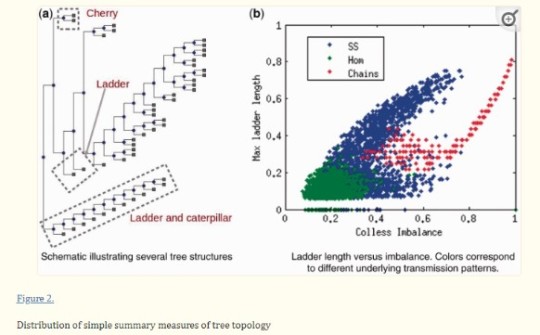
2 notes
·
View notes
Text
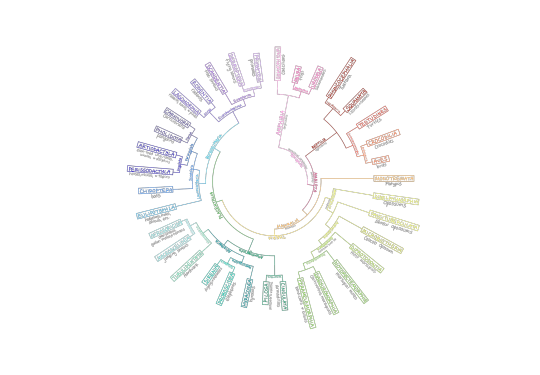
#biology#diagrams#evolutionary biology#phylogeny#phylogenetic tree#vertebrates#vertebrata#chordates#chordata#tetrapods#tetrapoda#amphibians#amphibia#reptiles#reptilia#birds#aves#mammals#mammalia#animals#marsupials#marsupialia#theria#placentalia#amniotes#amniota
2 notes
·
View notes
Text
Thus, the species which lived at the sixth great stage of descent in the diagram are the modified offspring of those which lived at the fifth stage, and are the parents of those which became still more modified at the seventh stage; hence they could hardly fail to be nearly intermediate in character between the forms of life above and below.

"On the Origin of Species by Means of Natural Selection, or the Preservation of Favoured Races in the Struggle for Life" - Charles Darwin
#book quote#the origin of species#charles darwin#nonfiction#evolution#natural selection#intermediate#cladogram#phylogenetic tree#modification
0 notes
Text
The accompanying diagram will aid us in understanding this rather perplexing subject. Let A to L represent the species of a genus large in its own country; these species are supposed to resemble each other in unequal degrees, as is so generally the case in nature, and as is represented in the diagram by the letters standing at unequal distances.
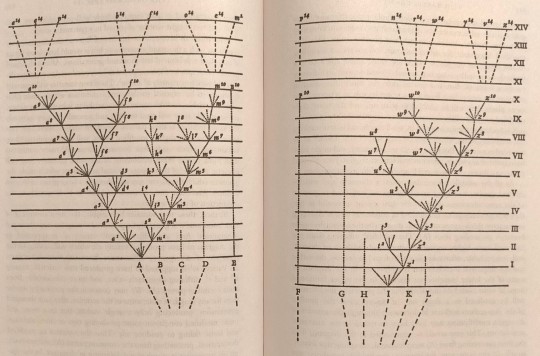
"On the Origin of Species by Means of Natural Selection, or the Preservation of Favoured Races in the Struggle for Life" - Charles Darwin
0 notes
Text
what's the name of the ultimate common ancestor. the one who started it all.
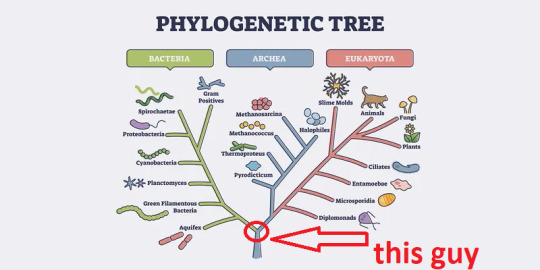
i wanna know if he had friends who never made it big like he did
0 notes
Text
@krmoaten-blog found out that Gaismagorm has retractable gill-like structures on its arms and back, which means that I had to update the Giasmagorm section on the Polypterygian document as well as push back when specialized dermal tissue evolved in elders.
I swear to god I can’t go three days without having to edit this damn thing
#monster hunter#monsterhunter#monhun#monster hunter biology#speculative biology#speculative evolution#speculative zoology#phylogenetic tree#phylogeny#phylogenetics#cladogram#cladograms#taxonomy
12 notes
·
View notes
Link
I hate sharing things from this ilk website but this is porn.
1 note
·
View note
Link
Fig. 2: Phylogenetic tree of the full-length genome sequences of SARS-CoV-2, SARSr-CoVs and other betacoronaviruses.
#Phylogenetic tree#biological WMD#wuhan institute of virology#ccp virus#print this off later#sars-cov-2#furin cleavage site
0 notes
